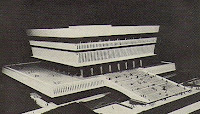 The annual Researching New York Conference, entitled 400 Years of Exploration: The Hudson – Champlain Corridor and Beyond, will take place today and tomorrow (November 19th and 20th). What follows is the conferences free and open to the public featured events, and even those who cannot attend the conference will find the Thursday evening sessions at the State Museum, as well as the Friday plenary session, interesting. Both those events are free and open to the public.
The annual Researching New York Conference, entitled 400 Years of Exploration: The Hudson – Champlain Corridor and Beyond, will take place today and tomorrow (November 19th and 20th). What follows is the conferences free and open to the public featured events, and even those who cannot attend the conference will find the Thursday evening sessions at the State Museum, as well as the Friday plenary session, interesting. Both those events are free and open to the public.
The full conference program is available in the History Department and at http://nystatehistory.org/researchny/rsny.html. Questions may be directed to [email protected]. UAlbany student/faculty registration for the entire conference and the lunch is $20.00.
Thursday, November 19 (at the State Museum)
4:00-5:00 pm:
Library Manuscripts and Special Collections/Archives Open House, 11th Floor
The New York State Archives, www.archives.nysed.gov, and the New York State Library Manuscripts and Special Collections, http://www.nysl.nysed.gov/mssdesc.htm, share the 11th floor of the Cultural Education Center. Examples from both collections will be on
display- staff from both institutions will be available to give overviews of their collections and answer questions. Limited to 30 people, registration requested. Call (518) 408-1916 to reserve a spot. Walk-ins are welcome if space is available.
State Library Workshop, 7th Floor Computer Classroom
Library staff will demonstrate navigating the Library’s website, http://www.nysl.nysed.gov/research.htm, including the services and electronic resources available to researchers. Sheldon Wein and Cara Janowsky will also demonstrate how to find and access items in the Library’s digital collections. Limited to 19 people, registration requested. Call (518) 474-2274 to reserve a spot. Walk-ins are welcome if space is available.
5:00-6:00 – Gallery Talks
The scholars and museum professionals who were integral in the creation of these exhibits will lead talks in the respective galleries.
�″- – Charles Gehring, The New Netherland Project, New York State Library
“Through the Eyes of Others”: African Americans & Identity in American Art – Gretchen Sullivan Sorin, Cooperstown Graduate Program
“This Great Nation Will Endure:” Photographs of the Great Depression – Herman R. Eberhardt, Supervisory Museum Curator, Franklin D. Roosevelt Presidential Library & Museum
7:00 PM – LECTURE
The Future of History in the Empire State – Kenneth T. Jackson, Columbia University
Kenneth T. Jackson is one of the country’s leading scholars in American history. Currently the Jacques Barzun Professor of History and the Social Sciences and Director of the Herbert Lehman Center at Columbia University, Jackson has for years championed the importance and excitement of New York State history. His influential 2006 essay “But It Was in New York: The Empire State and the Making of America” challenged historians to convince their “fellow citizens that today’s America took shape in yesterday’s New York.” Expanding on that theme, Professor Jackson will examine subsequent events–including the Hudson-Champlain Quadricentennial, planning for the New York State Museum’s proposed permanent exhibition on state history, the creation of
the New York Academy of History, new public school curricula, and more-as he challenges us to look to the future of New York’s history.
The discussion will be moderated by Jeffrey Cannell, Deputy Commissioner for Cultural Education, New York State Department of Education.
Friday, November 20
12:00 LUNCH/KEYNOTE, Campus Center Ballroom **
“Seeing with Explorers’ Eyes and Finding the Wild in the Hudson Valley” – David Stradling, University of Cincinnati
(** NOTE: For those who would like to hear Stradling, but not registering for lunch, seating available at 12:30 PM.)
For 400 years European and American explorers – from Henry Hudson to modern urban tourists – have traveled through the Hudson Valley. Stradling examines how the perceptions of these explorers have influenced public policy, especially preservation and conservation, in an attempt to explain why this heavily populated region still appears to be so wild. His publications include Making Mountains: New York City and the Catskills and Smokestacks and Progressives: Environmentalists, Engineers, and Air Quality in America, 1881-1951.
3:30 PM CLOSING PLENARY
The Tappan Zee Bridge: Transforming Rockland County
The Tappan Zee Bridge: Transforming Rockland County chronicles the dramatic changes that the Tappan Zee Bridge brought to Rockland County, transforming a quiet, rural farming community to a sophisticated New York City suburb. It tells the story of the bridge, through rare photographs, drawings, blueprints, and oral histories from workers- those who were relocated, or otherwise affected by the construction of
the bridge and the NYS Thruway extension. Funded in part with a “Preserve America” grant from the Federal Parks Service in partnership with the County of Rockland, and Rockland County Tourism, the film is a part of the larger Tappan Zee Project of the Historical Society of Rockland County, which also includes teacher’s guide, museum exhibition, and companion book.
Completed in 1955, this three-mile link between New York’s Westchester and Rockland Counties was a response to the post-war housing shortage, our national love affair with the automobile, and the power of the American dream. A replacement for the Tappan Zee Bridges in the planning stage, making it imperative that we preserve the tumultuous
story of this historic bridge and how it brought both immigration and heritage tourism to Rockland County-and is part of the larger story of suburbanization in America. The Project also offers a window into the value of local historical collections, innovative public history projects, and ways to tell stories from the archives.
Annmarie Lanesey, MZA Multimedia, Troy, NY Gretchen Weerheim, The
Historical Society of Rockland County
Comment: Sheila Curran Bernard, University at Albany, SUNY







